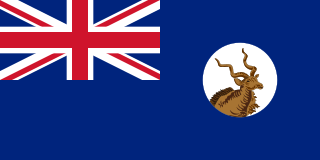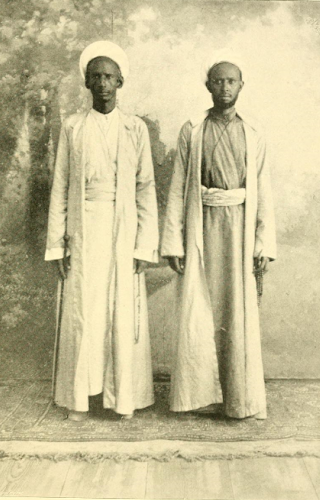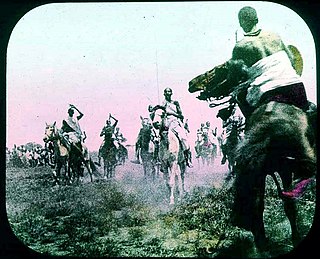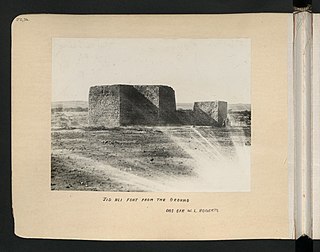
British Somaliland, officially the Somaliland Protectorate, was a protectorate of the United Kingdom in modern Somaliland. During its existence, the territory was bordered by Italian Somalia, French Somali Coast and Abyssinia. From 1940 to 1941, it was occupied by the Italians and was part of Italian East Africa.
The Dhulbahante is a Somali clan family, part of the Harti clan which itself belongs to the largest Somali clan-family — the Darod. They are the traditional inhabitants of the physiographic Nugaal in its topographic sense, and its pre-independence administrative sense, which included Doollo. The clan's progenitor is buried at Badweyn.

Muḥammad ibn 'Abdallāh Hassan was a Somali religious, political, and military leader who founded and headed the Dervish movement, which led a Holy war against British, Italian, and Ethiopian intrusions in the Horn of Africa. Due to his successful completion of the Hajj to Mecca, his complete memorization of the Quran and his purported descent from the Islamic prophet Muhammad, his name is sometimes preluded with honorifics such as Hajji, Hafiz, Emir or Sayyid. He was famously known by the British Empire as the Mad Mullah. In 1917, the Ottoman Empire referred to Hassan as the "Emir of the Somali". His influence led him to being regarded as the “Father of Somali nationalism”.

Taleh is a historical town in the eastern Sool region of SSC Khaatumo. As of September 2015, both Khatumo and Somalia had nominal influence or control in Taleh and it's vicinity. The town served as the capital of the pre-independence Dervish movement.

The Somaliland Campaign, also called the Anglo-Somali War or the Dervish War, was a series of military expeditions that took place between 1900 and 1920 in modern-day Somalia. The British were assisted in their offensives by the Ethiopian Empire and the Kingdom of Italy.

The Somaliland Camel Corps (SCC) was a British Colonial Auxiliary Forces unit which was raised in British Somaliland. It existed from 1914 until 1944.
The fifth expedition of the Somaliland campaign, which took place in 1920, was the final British expedition against the Dervish forces. Although the majority of the combat took place in January, British troops had begun preparations for the assault as early as November 1919. The British forces included elements of the Royal Air Force and the Somaliland Camel Corps. After three weeks of battle, Diriye Guure's Dervishes were defeated, bringing an effective end to their 20-year resistance.

Richard Conyngham Corfield was a British colonial police officer who saw service in South Africa, Nigeria, India, Kenya and Somalia in the early 20th century.

The Dervish Movement was a popular movement between 1899 and 1920, which was led by the Salihiyya Sufi Muslim poet and militant leader Mohammed Abdullah Hassan, also known as Sayyid Mohamed, who called for independence from the British and Italian colonisers and for the defeat of Ethiopian forces. The Dervish movement aimed to remove the British and Italian influence from the region and restore the "Sufi system of governance with Sufi education as its foundation", according to Mohamed-Rahis Hasan and Salada Robleh.

Ismail Mire Elmi, was a renowned Somali poet and. Regarding his poetry, one observer said his voice and poetic ability was "so great that he could sing his countrymen into peace or war".

Ahmed Warsama, more commonly known as Haji Sudi was one of the leaders behind the Somali Dervish movement. He was also the movement's right-hand man and chief lieutenant till its demise in 1920. He is described as the Mullah's right hand in the earlier days of his rise. He hailed from the Adan Madoba sub-clan of the Habr Je'lo clan.

SultanNur Ahmed Aman, was a learned religious leader and the 5th Sultan of the Habr Yunis Sultanate and later also one of the leaders behind the Somali Dervish movement and revolt (1899–1920). He was the principal agitator rallying the followers of the Kob Fardod Tariqa behind his anti-French Roman Catholic Mission campaign that would become the cause of the Dervish uprising. He assisted in assembling men and arms and hosted the revolting tribesmen in his quarter at Burao in August 1899, declaring the Dervish rebellion. He fought and led the war throughout the years 1899–1904. He and his brother Geleh Ahmed were the main signatories of the Dervish peace treaty with the British, Ethiopians and Italian colonial powers on March 5, 1905, known as the Ilig Treaty or the Pestalozza agreement. Sultan Nur is entombed in a white-domed shrine in Taleh, the location of the largest Dervish forts and the capital of the Dervish from 1912 to 1920, a testimony to his contribution in creating the movement.
Haroun, also called Fadhiweyn, and natively transliterated as Xarunta in Somali, was a government and headquarters of the Dervishes, headed by Faarax Mahmud Sugulle. According to Claude Edward Marjoribanks Dansey, the political officer in the British Somali Coast Protectorate consisted of 400 individuals. The capture of the haroun was regarded as conceivably resulting in the Sayyid's surrender. In the third expedition, major Paul Kenna was tasked "by every means" to find where the haroun is.

Jidali fort was a cross-shaped fort of the Dervish era located in the town of Jidali in Sanaag, Somalia and is also the first place in Africa to be bombed via aerial bombardment by a tally of four sorties of De Havilland DH-9's on 21 January 1920. An April 1920 letter between the Sayid and Italian-Somali governor Giacomo De Martino states that the Dervishes built a total of twenty-seven forts which are described as Dhulbahante garesas.
Adan Ali Gurey was a political advisor in the Darawiish, an anti-colonial instigator, the commander of Golaweyne, a chieftain of the Dhulbahante, and an arms supplier.

Dhowre Ali Sheneeleh was the castellan of the Darawiish fort / Dhulbahante garesa of Eyl, whilst the governor of Nugaaleed-Bari for the Darawiish was Ali Meggar. He was also the primary commander which spearheaded opposition to Abyssinian expansionism towards the east in the 1900s.

Haji Mohamed Bullaleh commonly known as Haji Warabe was an early 20th century Akil (chief) of the Habr Yunis Rer Ainanshe.
The Mohamoud Garad is a Somali clan. Its members form a part of the Dhulbahante, a sub-division of the Harti/Darod clan-family. The clan is divided into three main sub-clans ― namely the Jama Siad, the Ugaadhyahan and Omar Wa’eys.
The Dhulbahante Garadship is presumed to have began in the 16th century with Garad Shishore assuming the royal title in approximately 1530. During the 19th century, the Dhulbahante garadate morphed into a dual monarchy. The current Garad, Garad Jama Garad Ali hails from this long line of succession.
The Battle of Jigjiga was fought on March 5, 1900 between the Ethiopian Empire and the Dervish movement.














